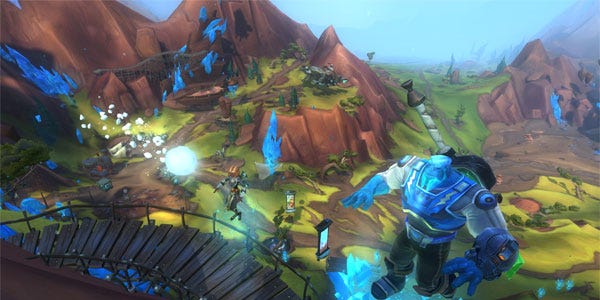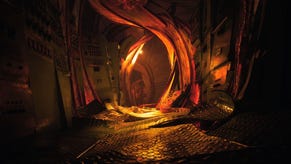Viewed Prior To Release: Wildstar
a lost planet of legendary status
We sent Brendan to see Wildstar. This is his report.
A lot of good games have come from pitting the player against ‘the frontier’. (What is Minecraft, for instance, if not a blocky representation of a pre-civilisation?) On paper, the MMO genre seems perfectly suited to the frontier, since it could so easily harness real human nastiness to provide the sense of danger and lawlessness. Some MMOs, like EVE, embrace that interpretation of the wild, at the expense of giving new and inexperienced players an easy ride. On the other hand, WildStar – a new project by NCSOFT currently in beta – is shaping up to be a much more conventional, welcoming game world. A place where the frontier is a cartoon one.
It is set on the newly discovered Nexus, a lost planet of legendary status, thought of universe-wide as a source of riches and adventure. A sort of intergalactic El Dorado. The player’s role is of courageous frontiersman or frontierswoman, who must go out into the dangerous wild. But this is a thematic wildness, provided by the setting, lore and NPCs, rather than a ‘real’ wildness, which is always best provided by the threat of other players. Although there will obviously be PvP elements, they are distanced from the PvE part of the game in ways that will be instantly familiar to MMOers – but more on that later.
The character creation screen is likewise familiar, offering an assemblage of alien races and classes. To give a few examples, there are the Draken (one part goat, one part lizard, one part beard), the Aurin (very thin, lots of hair, rabbit ears) and the Mechari (a transformer, minus the transforming). The classes are fairly customary RPG types. The ‘Warrior’ as tank, the ‘Spellslinger’ as damage-dealing mage, the ‘Esper’ as healer and support, and so on. Although some races are limited in what class they choose, this limitation is somewhat offset by an extra layer of variety: the ‘Paths’ system. This allows you to adopt one of four professions on top of your character’s build so far – Soldier, Scientist, Explorer or Settler. It might sound a little elaborate but really all this means is that there are three tiers of creation – race, class, path – resulting in any number of combinations.

Each of these ‘paths’ is permanent and each has a variety of mission types particular to them. The Scientist’s missions, for instance, focus on unlocking secret labs or ancient structures, cataloguing the planet’s flora and fauna, hacking enemy computers, and generally Indiana Jonesing about. The Explorer’s missions are all about going further and further across the map, charting new areas and staking a claim for your alliance. There are bits of equipment and objects scattered around which only certain professions can interact with, so if you want to completely farm an area of its XP, you would want someone from each path in your party. This way all players will get some XP for every computer your Scientist clicks on and every satellite dish your Explorer sets up, as you all go along vacuuming loot up from all the corpses the Soldier leaves behind.
In my two-hour long session, I played as a Spellslinging Settler, whose role is to build structures in towns and activate little do-hickeys in each settlement to keep the place appearing functional. I would go around town maintaining the banners, torches and satellite dishes for small amounts of XP. These devices would reset to their ‘deactivated’ state within 5 minutes for me or another Settler to come and do it all again. NCSOFT say that, thus far, these maintenance jobs are purely for appearance – the satellite dishes might whirr and rotate for a short time but they are more of a housekeeping activity and don’t currently help other players in any way.

There are some exceptions to this. Like when the Settler builds some sentry droids, which can guard the area and lend support in a fight. Or when you take on an ‘infrastructure’ mission. This is when you have to collect resources and build a hospital, prison, spaceport, or something else like that. Once constructed, these buildings will house new characters with quests for whoever wants to take them. The confusing catch being that the building will dissolve back into its ‘unbuilt’ state after a few minutes to allow other Settlers to build for XP. Unless, that is, other players keep adding resources to it. In this case, the structure will remain.
However, the Settler also has some advantages in combat or when scouring new areas with a party of players. There are construction posts close to enemy-infested areas where the Settler can build machines that give a boost to speed or max health. There’s another that increases the XP earned within a certain bubble. The idea is that your party will be about to tackle a bunch of laser-wielding spacesuits or irradiated jabberwockys and the Settler can prep the area with all these different buffs before the fight occurs.

And when the fights do occur it is very MMO. There are spells, stuns, high damage attacks, flurries – everything you might expect. But the Combat is also about range and positioning, with lots of wooden jumping, dodging, strafing, backflipping and double-jumping out of the big red glow of the enemy’s attack range. Simultaneously you want to make sure they remain within your damage-dealing ‘cone’. While this focus of constant movement will be refreshing to those looking for a little more dynamism in their dungeon, it can also feel a little cumbersome and took me some time to get used to. And, although the paths were the focus of the demo, most of my time was spent peppering generic bad dudes with bullets and leaping out of the way of their attacks, in order to rescue some prisoners from cages.
When I escaped from that, exploring the planet revealed a world that wasn’t afraid of verticality. There is a type of crystal on Nexus that acts like that most obscenely-named of minerals, ‘unobtainium’, in that it causes the overlying earth and rock to float. It has the same effect on the player when you are close to these crystals, allowing you to leap huge distances. All of which results in these rudimentary platforming sections where you are challenged to scale mountains at the behest of an insolent countdown timer which suddenly appears on screen.

NCSOFT have yet to reveal how the guild system will work but the PvP component will comprise of large battlegrounds, an arena for bouts of 2v2, 3v3 or 5v5, and something called ‘warplots’. These fights look to be similar to the sieges of Guild Wars 2, in that there is a settlement that has to be built up with defences by one team while being charged and razed to the ground by another.
Yet the most interesting aspect of WildStar is arguably the ‘frontier’ conceit. The website and promotional material so far suggests that, as a group, you will be able to go on an expedition into the unknown parts of the world and stake a claim on the land. But the exact mechanics concerning this part of the game haven’t been fully explained. The idea of your ‘home’ is one exception.
Players will be able to build and maintain their own house in the world and NCSOFT have come up with an admittedly clever solution concerning the limitation of space in the game world, by doing what every horrible megacity has been doing for decades and building ‘up’. In this instance, player housing will be placed on islands in the sky. But this also negates the chance of conflict over land space. Whether you’re a fan of that decision will depend on whether you like your MMOs to taste spicy or sweet. Personally, I think sticking to the safe road of disallowing your players to burn each other’s houses down somewhat defeats the idea of a game about frontiers. Then again, the closest I’ve ever come to enjoying an MMO was Mortal Online, so WildStar’s cuddly WoWish conventionalism doesn’t exactly feel targeted at me.
In fact, the question of WildStar’s target audience is an interesting one because its cartoon aesthetic and jokey promotional videos seem to be angling for a wide audience, not necessarily those who go from MMO to MMO. At the same time, the mechanics, quest types and XP-farming imply a requirement for genre fluency. Overall, I get the feeling of a game that is welcoming newcomers, while also being subtly aimed at a very particular 1.3 million people, or, at least, a sub-section of that diaspora. It has yet to reveal its business model or set a concrete release date but, as of April, the beta is underway. If the current taste for F2P doesn’t disappear we may soon be discovering that the frontier planet of Nexus really is a wild free-for-all.

















